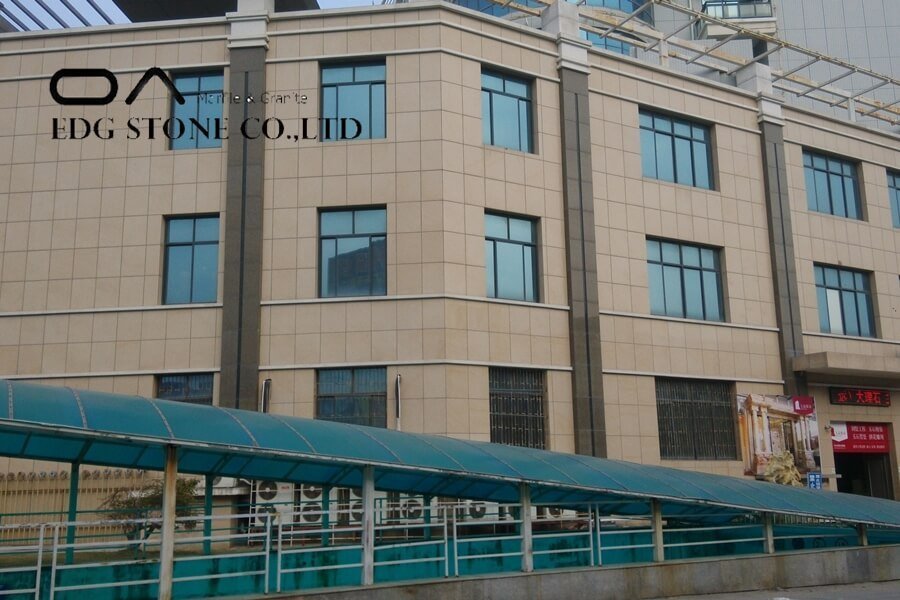1. Three elements of curtain wall leakage
Namely pores, rainwater, and wind pressure. Therefore, the stone slabs are embedded in the gaps of the structure and the geometry, size, and exposure of the slabs, as well as the size of the rain. The pressure difference between the inside and outside of the curtain wall has a direct impact on the rainwater leakage function of the curtain wall
2. The formation process of curtain wall leakage
When wind pressure and rainwater act on the surface of the curtain wall at the same time, the rainwater directly splashes into the room through the gap on the curtain wall or drips down the curtain wall. When the appropriate conditions are reached, gravity, surface tension, or capillary phenomena can penetrate into the room.

Concrete measures for anti-seepage of curtain wall
1. Eliminate the differential pressure opening method. The most ingenious way is to make no sealing strips in the crevices on the outside of the curtain wall. Move the sealing treatment to the opening on the indoor side, that is, move the pressure difference to the indoor opening where rainwater is not in contact so that there is no wind pressure in the water and no water in the pressure difference, which can avoid rainwater seepage. The possibility of leakage.
2. Sealing balance treatment method. The opening on the inside of the opening chamber should be sealed. This is to prevent high-speed air currents in the gaps and draw rainwater into the room. The height h of the inner flange of the beam steel with the possibility of water accumulation can be increased to improve the waterproof and leakage products.
Many experiments have proved that the height h of the inner flange is basically close to the critical detection wind pressure. Therefore, increasing the height h of the inner flange of the beam is an effective way to improve the watertight level.
Open water method
The curtain wall should be provided with an unobstructed drainage channel system so that the rainwater accumulated in the cracks can be quickly drained out, which is very important to improve the water tightness.
The main method is to rationally arrange the drainage system. Generally, the inlay seams are arranged along the outside, and the drainage holes should be arranged evenly. The spacing is generally about 500mm. The distance between the corners and the corners is not less than 20mm, but the maximum is not more than 100mm.

In order to avoid water in the mosaic tank, a certain pressure balance condition must be created. The horizontal distance between the drainage holes of the upper and lower beams should be more than 50mm to prevent air from colluding and pressing rainwater into the chamber.
Implementing measures
First, mark the location of the water leak that has been checked, and determine the location of the water leak on the curtain wall according to the size and flow direction of the water trace. The repair method is as follows:
1. Sealant construction. First, determine the lack of glue or lack of glue based on the inspection method by the eye and hand, and then repair and strengthen the glue.
2. Add sealing water line. A section of floating decorative line is added on the outer wall to block water and prevent rainwater from infiltrating.
3. Repair or replace some damaged materials
4. After the weather-resistant adhesive surface does not stick to your hands, test the water
Use a 2cm diameter hose to spray on the finished surface of the construction to determine whether there is still water leakage.

The concrete construction method of weather-resistant sealant
Weather-resistant silicone sealant is bonded on both sides of the joint, and the sealing groove is filled with a polyethylene foam gasket, so that a cavity is formed in the sealing groove, and no sealing strip is provided in the outer gap hole, and the opening is opened on the indoor side. Carry out sealing and gluing, move the pressure difference to the indoor opening that cannot reach the rain, and do so until there is no water but no wind pressure and there is no water in the part of the pressure difference, which has the effect of anti-leakage.
The construction thickness of the weather-resistant seal is controlled at 3.5mm-4.5mm, because too thin is not good for ensuring the quality of the seal and preventing rainwater leakage. At the same time, it is not good for the tensile stress of the steel due to thermal expansion and contraction, but it should not be too thick. When it is too thick, the tensile stress is easy to be destroyed, making the sealing and anti-leakage ineffective.
In the project, the construction thickness of the weather-resistant silicone sealant is 4mm, and the construction thickness is 10mm.